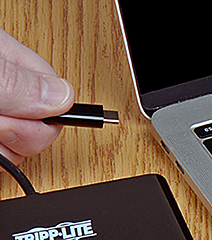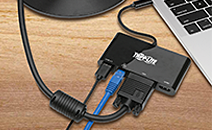
If you’ve purchased a new laptop computer recently, especially a MacBook or Chromebook, you may have noticed some missing ports. Apple and Google have scrapped many of their existing ports for USB‑C, and they’re not the only manufacturers who have done so.
The wide adoption of USB‑C may leave you wondering what you need to do to get your existing technology to connect with the new technology. For example, how are you supposed to connect the USB‑C port on your new MacBook to the VGA port on your external display? Don’t worry. Making the switch is easier than you might think, doesn’t require a lot of costly new equipment and comes with many potential benefits.
Is it worth it?

Even though purchasing a USB‑C adapter to charge your cell phone seems like a bit of a hassle, the benefits of USB‑C will far outweigh the inconvenience and cost. If you want to be ahead of the curve, you will definitely need a USB‑C upgrade because the standard is here to stay.
Some benefits of USB‑C include wide compatibility, fast speeds and USB Power Delivery. Let’s go through these features one‑by‑one.
Is the new USB‑C compatible with my older devices?
Fortunately, yes. First, the USB‑C format itself and most USB‑C connectors and cables are backward compatible with your older USB 3.0 and USB 2.0 devices.
Second, you can connect your new Chromebook to your HDMI or VGA television or monitor, among other examples. All you need is an adapter with a built‑in USB‑C cable that can plug into a video source with a USB Type‑C connector that supports either Thunderbolt 3 or DisplayPort Alternate Mode. At the other end, it will have ports designed to accommodate other connectors, including HDMI, VGA and Mini DisplayPort.

There are many types of USB‑C docking stations and adapters to choose from, so you’re very likely to find what you need. Some allow connection to USB‑A devices or a wired Ethernet network. Others have a headphone jack for connecting earbuds or a microphone or memory card slots to access old data.
Fast data transfer speeds
Some versions of USB‑C, such as USB 3.1 Gen 2, can support data transfer speeds up to 10 Gbps. That’s fast enough for downloading or uploading videos from your phone to your company blog or transferring image files to the monitor of your LCD digital signage. Some USB‑C ports support Thunderbolt 3, which potentially supports speeds up to 40 Gbps.
USB Power Delivery
Because USB‑C supports USB PD, it is capable of delivering various power levels up to 100 watts to devices capable of handling that much, such as the latest laptop-powered projectors. It can also charge your device up to 70 percent faster than standard 5W charging cables will. For instance, by connecting a Lightning cable to a USB‑C device that supports Power Delivery, you can charge an iPhone X to half capacity in a half hour.

Not all USB‑C ports support USB PD, however, and not all adapters are created equal. For quality USB‑C adapters, choose Tripp Lite. The company also has knowledgeable staff members who can answer any lingering questions and guide you to the products you really need.





